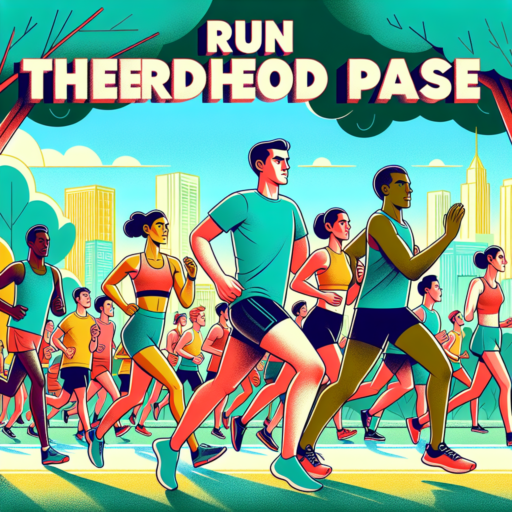Understanding the Basics of Strides in Running
When we talk about improving our running technique, one of the fundamental aspects we must focus on is the concept of strides. Strides, in essence, involve the length and frequency of our steps while running. Mastering the balance between these two factors can significantly enhance your running efficiency, speed, and even help in reducing the risk of injuries. Let’s delve deeper into understanding the basics of strides and how they play a pivotal role in the world of running.
The length of your stride refers to how far you travel with each step. Contrary to popular belief, longer strides aren’t always better. Overstriding can lead to excessive braking forces with each footfall, thus increasing the risk of injuries like shin splints or runner’s knee. On the other hand, a stride that’s too short can cause you to expend more energy as you take more steps to cover the same distance. The key is to find a stride length that’s efficient and comfortable for you, typically where your foot lands directly under your body’s center of gravity.
Similarly, stride frequency, or the number of steps you take in a minute, is equally crucial. It’s often recommended to aim for a higher step rate to improve running efficiency. This doesn’t necessarily mean running at a faster speed, but rather taking quicker, more frequent steps. Research suggests that an optimal stride rate is around 180 steps per minute, but this can vary based on an individual’s height, leg length, and running experience. Adjusting your stride frequency can help you avoid overstriding and make your runs feel more effortless.
The Importance of Proper Stride Mechanics for Efficiency and Speed
Understanding and mastering proper stride mechanics is crucial for any runner or athlete looking to improve both their efficiency and speed on the track or field. Efficiency in running is about maximizing the energy you expend towards propelling yourself forward, while speed is the outcome of powerful and effective movement. Proper stride mechanics help in minimizing wasteful motions and directing energy in a forward trajectory, optimizing both factors significantly.
One key aspect of stride mechanics is the foot strike pattern. This pattern plays a crucial role in how force is distributed through your body upon landing. Ideally, landing on the mid-foot allows for a more natural, shock-absorbing motion that reduces injury risk and improves propulsion. Adjusting your stride to achieve this can make a substantial difference in running economy, thereby enhancing endurance and sprint speeds.
Core Strength’s Role in Stride Mechanics
Core strength is often overlooked in the context of running mechanics. However, a strong core stabilizes your torso, maintaining your center of gravity and preventing unnecessary oscillations that waste energy. This conservation of energy directly feeds into greater efficiency and, subsequently, increased speed. Moreover, a well-conditioned core enhances coordination between your upper and lower body, further optimizing your stride mechanics for better performance.
How to Measure and Improve Your Running Stride Length
Improving your running stride length can have a significant impact on your running efficiency and speed. Measuring and then working to enhance it involves a blend of techniques and exercises designed to boost your overall performance. Here, we delve into how to accurately measure and methodically improve your running stride for better outcomes.
Measuring Your Running Stride Length
To measure your stride length, start by marking a straight distance that you can run across, like a track. Run at your average pace and count the number of steps you take. Measure the distance in feet or meters, and then divide this by the number of steps. The result is your average stride length. Remember, accuracy in these measurements is key to effectively track improvement.
Techniques to Improve Your Stride Length
Improving your stride length is not solely about making longer strides but optimizing each step for better performance. Exercises such as hill sprints and plyometric drills can significantly contribute to increasing your muscular strength and power, leading to an enhanced stride. Additionally, focusing on your flexibility through dynamic stretching can improve your range of motion, allowing for a more effective stride.
Incorporating Strides into Your Running Routine for Better Performance
Adding strides to your running routine is a powerful way to enhance your running performance. Strides, which are short accelerations where you gradually increase your speed until you reach a near-sprint, can significantly improve your running form, efficiency, and speed. These quick bursts of speed are not just about pushing your limits; they’re also about teaching your body how to move more effectively.
Why Incorporate Strides? Incorporating strides into your training has multiple benefits. Firstly, they help in refining your running mechanics by promoting foot speed and encouraging a proper footstrike, which collectively enhance your efficiency as a runner. Secondly, strides serve as an excellent warm-up exercise that prepares your body for the more demanding workout ahead, reducing the risk of injury. Furthermore, by regularly integrating strides, runners can improve their anaerobic capacity, a critical component for those looking to improve their speed and endurance over short distances.
Techniques for Effective Strides
- Start Slow: Begin your stride by running at a moderate pace and gradually increase your speed until you’re at about 95% of your maximum effort.
- Keep It Short: Strides should be short, typically between 60 to 100 meters. This distance is enough to improve your speed without causing fatigue.
- Maintain Form: Throughout the stride, pay close attention to maintaining good running form. Keep your chest open, your shoulders relaxed, and make sure your foot lands under your center of gravity.
Integrating strides into your running routine is an effective way to enhance your performance. Start by adding them once or twice a week, focusing on technique and gradually increasing frequency as your body adapts. Remember, the goal of strides is not just to run faster, but to run smarter, by improving technique and efficiency. With consistent practice, strides can be a game-changer in achieving your running goals.
Common Mistakes to Avoid in Your Running Stride Technique
Improving your running stride technique is crucial for enhancing performance and avoiding injuries. However, many runners inadvertently make mistakes that can impede their progress and lead to long-term issues. Recognizing and correcting these errors can vastly improve your running experience. Below are some common blunders to be mindful of in your pursuit of a better stride.
Overstriding
One of the most frequent mistakes runners make is overstriding. Overstriding happens when your foot lands well ahead of your center of gravity, leading to a braking effect with each step. This not only slows you down but also increases the risk of injury by placing excessive stress on your knees and shins. To correct this, focus on landing your foot directly under your body and increase your cadence to maintain speed without stretching your stride too far.
Ignoring Upper Body Form
While the legs do most of the work in running, ignoring the role of your upper body can lead to inefficiencies in your stride. Many runners tend to hunch their shoulders or swing their arms side-to-side, which can disrupt balance and momentum. Concentrate on keeping your shoulders relaxed and down, with your arms swinging forward and back in a controlled manner. This alignment ensures your energy is propelled forward, enhancing your overall stride efficiency.
Benefits of Optimizing Strides for Injury Prevention in Runners
Optimizing stride length and form in runners is not just about enhancing performance, but it’s also a crucial step in reducing the risk of injuries. When runners adjust their strides to an optimal length, they can achieve a more efficient running form, which directly impacts their ability to run safer and more effectively. This focus on stride optimization offers a plethora of benefits, ensuring runners can maintain their training regimen without unexpected setbacks caused by injuries.
Improved Joint Health is one of the significant advantages of optimizing strides. Overstriding can lead to excessive force on the knees and hips, increasing the risk of joint pain and injuries such as runner’s knee or IT band syndrome. By adjusting their stride length, runners can minimize the impact on their joints, leading to healthier, more resilient knees and hips. This adjustment not only helps in preserving joint health but also extends a runner’s longevity in the sport.
Enhanced Muscle Coordination is another benefit that cannot be overlooked. A well-optimized stride promotes balanced muscle activation, reducing the reliance on a single muscle group and distributing the workload more evenly across the muscles. This balance in muscle usage prevents overuse injuries, such as shin splints and stress fractures, by ensuring no single muscle group is overstressed. Additionally, improved muscle coordination enhances overall running efficiency, contributing to better performance and endurance.
Finally, optimizing strides leads to Reduced Recovery Times. When runners suffer from fewer injuries thanks to a refined stride, they inherently spend less time recovering and more time training. This continuous, uninterrupted training cycle allows for consistent progress and development. Furthermore, an optimized stride decreases the overall stress on the body, meaning post-run recovery is faster, enabling more productive training sessions with less downtime.
The Role of Footwear in Enhancing Your Running Strides
Understanding the role of footwear in enhancing your running strides is crucial for runners seeking to maximize their performance and reduce injury risks. The right pair of running shoes can significantly influence your running efficiency, affecting how your foot strikes the ground, the distribution of impact, and your overall running economy. It’s not merely about cushioning or aesthetics; it’s about biomechanical compatibility and support.
One of the key benefits of selecting the appropriate footwear is the improvement in stride efficiency. A well-chosen shoe can encourage a more natural running motion, reducing the energy expenditure for each stride. This efficiency gain translates into better endurance and potentially faster times. Moreover, shoes with the right level of support can help in correcting overpronation or supination, common issues that can lead to injury if unchecked.
The advancement in footwear technology has led to the development of shoes tailored to different types of runners. Features like energy-returning midsoles, supportive yet flexible upper materials, and sophisticated cushioning systems are now commonplace. These innovations aim to enhance runner comfort, improve foot alignment during strides, and offer protection from the repetitive impact of running, all of which contribute towards a more productive and enjoyable running experience.
No se han encontrado productos.
Case Studies: How Professional Runners Use Strides to Gain Competitive Edge
In exploring how professional runners use strides to enhance their athletic performance, we delve into the core techniques that set them apart. Strides, short accelerations used to improve running form and efficiency, are a staple in the training regimes of elite athletes. This approach not only hones their speed but significantly boosts endurance, enabling them to maintain a competitive edge across long distances.
The Strategic Incorporation of Strides forms the cornerstone of a professional runner’s training plan. By seamlessly integrating these exercises into regular workouts, athletes witness a marked improvement in their leg turnover and flexibility. This method is particularly beneficial in conditioning the body to switch gears quickly, a vital skill in outracing competitors during the crucial final moments of a race. Moreover, the emphasis on strides aids in muscle recovery, ensuring runners are in peak condition for their next training session or event.
Variation in stride technique and application further illustrates the meticulous nature of professional training. Whether focusing on uphill strides for strength and power or downhill strides to improve control and resistance, each method serves a distinct purpose in enhancing overall performance. Through detailed case studies, we see athletes employing these varied techniques to target specific weaknesses, thereby sculpting a well-rounded and formidable racing strategy.
Strides vs. Sprints: Understanding the Differences for Training Purposes
When discussing the nuances of running workouts, the terms strides and sprints often come into play, especially when tailoring training for specific athletic goals. Though both are integral to enhancing performance, understanding their distinct characteristics is crucial for optimizing training methods. Strides, often misconceived as just a slower version of sprints, are actually short accelerations where the focus lies on technique and speed increment. On the other hand, sprints demand explosive bursts of maximum effort over a shorter distance.
One of the key differences between strides and sprints lays in their purpose and integration into training regimes. Strides serve as an effective warm-up or cool-down activity, preparing the body for more intense workouts or aiding in recovery post-exercise. They are typically performed over 60-100 meters, emphasizing form and gradually increasing speed. Conversely, sprints are structured as the core component of speed training, aiming to push the body’s limits in terms of velocity and power over distances generally not exceeding 400 meters.
Implementing strides and sprints into an athlete’s routine requires understanding their individual impacts on the body. Strides help in developing a better running form, enhancing efficiency, and increasing foot turnover without imposing excessive stress. Sprints, with their exhaustive nature, contribute significantly to improving an athlete’s anaerobic capacity, power, and endurance. The ability to discern when and how to incorporate these elements can markedly influence the effectiveness of a training program.
Tips for Beginners on Mastering the Art of Running Strides
Understanding and mastering running strides can significantly impact your running efficiency and performance. As beginners, it’s crucial to grasp the basics of proper running form and how to incorporate strides into your training routines. Here, we will explore some foundational tips to help you get started.
Start with Proper Form
Focusing on the correct form is paramount when performing running strides. Ensure your body is relaxed, your posture upright, and you’re making light, quick steps. Concentrate on pushing off the ground with your toes, not your heels, and keep your arms swinging smoothly at your sides. This approach reduces injury risk and makes your strides more effective.
Incorporate Strides Gradually
Begin with short, 20-30 second strides, gradually integrating them into your regular training sessions. It’s advisable to start incorporating strides one to two times a week, allowing your body to adapt without overwhelming it. Over time, you can increase the frequency and duration of the strides as your fitness level improves.
Listening to your body is key when mastering running strides. Pay attention to how your body feels during and after the run and adjust your training accordingly. With consistency and patience, incorporating strides will enhance your running performance, making you a more efficient runner.




